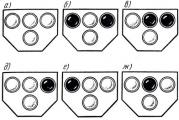How to make a do-it-yourself fly swatter out of paper. Electronic Insect Trap
Each warm season - from spring to autumn, the entire foreseeable history of man's existence is pestered by various harmful insects, and the stronger, the closer to nature he is. And the most common of them, of course, are mosquitoes and flies. The man waged a fight with them always and everywhere, but he still could not win a complete victory. But it is known that even one mosquito can keep you awake all night, and an annoying fly interferes with work so much that it can throw you out of balance. Therefore, the "weapon" against them (for example, an ordinary fly swatter) should always be ready and at hand.
However, the commercially available fly swatter, even with a careful blow, flatten the insect so that only a wet place remains of it, but unfortunately it is bad or not at all washed off. So you have to wait until a fly or a mosquito sits on a place where you can kill an insect without undesirable consequences, and the hunt sometimes drags on for a long time.
So I had to invent my own fly swatter.
The shape and design of the fly swatter are traditional: the striker is in the form of a shovel attached to a rather long, thin handle. But there are in this weapon against insects and "proprietary" features. The handle consists of a rod made of thick aluminum wire and a sheath put on it - a PVC tube. If necessary, the handle can be bent to act as a "weapon" from around a corner or in a place that is hard to reach (for a fly swatter with a straight handle).
The free end of the handle bar is bent into a ring so that the fly swatter can be hung for storage on a hook or just a nail in the wall. But the main trademark is in the material of the striker.
Probably, many remember how in childhood they sometimes managed to catch soap bubbles with their hands, dressed in woolen mittens. This led to the idea of making the firing pin from a similar material, only denser and heavier.

1 - firing pin (from the bootleg of an old felt boot), 2 - seam (harsh thread); 3 - handle sheath (PVC tube); 4 - handle bar (aluminum wire Ø8)
And I picked up such material - a bootleg from an old Siberian felt boot. In the warmer parts of Russia, felt boots, even old ones, are more difficult to find. Then you can use a thick thick woolen insole for the striker.
To attach the firing pin to the handle, I cut a 20-mm groove in the shell with the width of the striker, and at the end of the rod I grinded a flat and drilled two diametrical holes in the rod and the shell perpendicular to it. Through these holes, the firing pin was sewn to the handle with harsh threads.
Having tested the weapon in practice, I was convinced that it hits insects (both flies and mosquitoes) on the spot and without traces - even on smooth glass, and without the excessive noise-cotton characteristic of an ordinary fly swatter with a rubber or plastic "warhead".
A. MATVEYCHUK, Zavodoukovsk, Tyumen region.
From early summer to late autumn, the rest or entertainment of many summer residents and tourists is hampered by nightlife - clouds of flying insects, moths, etc. "Electronic" protection is suitable against them. which although not as effective. as pesticides, but more respectful of the environment!
The following is a description of such an insect trap.
Our trap comes from the "psychology of insects" that the light of an incandescent lamp lures them towards itself. And here they are trying to get through the wire mesh to the lamp.
The stretched wire mesh is connected to high voltage. The individual wires are at such a distance from each other that the breakdown strength of the air is at its limit.
An insect flying through the net reduces this distance, so an insect passes through its body electricity high-voltage discharge, and the insect dies.
The foregoing already allows us to suspect that we are talking about a device where electronics - due to its extreme simplicity - is a minor problem in comparison with mechanical design. Despite this, we will first consider electrical circuit, which is shown in Fig. 1 and is offered in two versions.
This scheme is divided into the following main blocks:
- surge suppressor filter (noise filter);
- electronic regulator:
- high voltage transformer.

The circuit (Fig. 1a) works as follows. Capacitor C2 is charged from the mains voltage through the diode rectifier D1 and resistor R2 to the peak mains voltage (310 V). This voltage goes through the primary winding of the transformer T1 to the anode of the thyristor Th.
On the other branch (Rl, D2, C1), the capacitor C1 is slowly charging. When during charging C1, the breakdown voltage of the D1 dinistor is reached (within 25 ... 35 V), the capacitor C1 is discharged through the control electrode of the thyristor Th and opens it. Through the open thyristor and the primary winding of T1, C2 is discharged very quickly.
The pulsed varying current induces a high voltage in the secondary winding of T1, the value of which can exceed 10 kV.
After the capacitor is discharged, the thyristor closes and the process repeats.
The permissible cell voltages must correspond to the values indicated in the diagram. The most important problem is the manufacture of a high-voltage transformer.
High voltage transformer
You can use a ready-made high-voltage winding, which is nothing more than the secondary winding of the transformer. line scan black-and-white television set (known as "millstones"). The work of the transformer in a quiet time is somewhat "grumpy".
However, the sound phenomena accompanying the work are even useful - after all, they indicate the presence of high voltage. for example, when an incandescent lamp in a trap burns out.
A silently operating device could play a cruel joke with an unsuspecting passer-by inadvertently approaching.
An input surge suppressor is a necessary companion to any thyristor controlled circuit. The device generates radio and TV interference, and the filter unit makes it easy to watch radio and TV programs.
Wire curtain and mechanical structure
The most critical part of our design is the very precise fabrication of the wire "curtain". To obtain it from some good insulating material (for example, from a textolite or plexiglass plate 4 mm thick), two discs with a diameter of 170 mm and two discs with a diameter of 150 mm are cut.
Along the perimeters of each pair of discs, after 10 °, cuts are made with a jigsaw with a depth of 5 mm (36 pieces). Then, on the discs, they are marked at 120 ° and holes with a diameter of 5 mm are drilled.
After that, the support holders are made. In the prototype, these were 3 brass rods 210 mm long and 5 mm in diameter, at one ends of which there was a thread 50 mm long. and on the second - 30 mm long.
The discs are assembled so that the two smaller ones are on the inside and the two large ones are on the outside.
On the threaded ends of the rods, discs with small and large diameters are installed at a distance of approximately 15 mm from each other.
It is advisable to install the slots of the small and large discs as follows. so that they do not fall on the same line, but are shifted towards the middle in relation to each other by about 15 mm.
The bottom of the frame will be those discs into which the ends of the rods with a longer thread are screwed, and with a shorter one - the cover.
If the frame is normally assembled, the upper discs are removed, and holes for the incandescent lamp holder are sawn in the middle with a jigsaw.
The dimensions depend on the lamp used. I used a mignon lamp holder.
It is also necessary to take care of such a fastening of the holder (for example, removable from the top) so that the lamp can be replaced without disassembling the mesh.
For the mesh, an uninsulated copper wire with a diameter of 0.45 ... 0.5 mm was used. It must first be immediately pulled into the slots along the perimeter of the disc. If you use enamel-insulated wire, the work will increase somewhat. It is necessary to remove the insulation from it along the entire length with sandpaper.
After installing the inner and outer parts of the curtain, the ends are taken from the large and small discs and connected to the ends of the high voltage winding.
The finished structure is secured to a suitable plastic box in which the electronics are placed.
Installation and operation
The shape of the board must match the shape and dimensions of the plastic box.
The high-voltage transformer is assembled like this.
 The primary winding is removed from the high-voltage transformer core "obtained" from the TV, and a new coil is made in accordance with its dimensions.
The primary winding is removed from the high-voltage transformer core "obtained" from the TV, and a new coil is made in accordance with its dimensions.
For the new primary winding, a winding wire with a diameter of 0.8 mm is used. The number of turns is 25. Any defect-free "millstones" for a black-and-white TV are suitable for the secondary winding.
For a surge filter, high-frequency ferrite cores with about 20 turns of a winding wire with a diameter of 0.6 ... 0.8 mm are best suited.
After the final installation in place of the electronics board, the network cable, and the wire curtain is connected to the "millstones". After switching on, the light comes on, and the whole device quietly "grumbles", signaling the presence of high voltage.
Sparks do not escape through the double wire mesh. If they do slip, then either the voltage is too high or the rows of wires are too close to each other. With fixed geometric dimensions of the "curtain", the required voltage is set by adjusting the electronic circuit.
The test ends with a spark test with a screwdriver. Slide the screwdriver between the two rows of wires - now sparks should slip onto the screwdriver from both sides.
The large internal resistance of the transformer winding in itself protects against a dangerous current value during the formation of a discharge.
Despite the non-lethal value of the current generated by the circuit, I still strongly remind you to follow the rules associated with working with high voltage, as in manufacturing. and during operation.
Touching the wire cage with your hands will be quite unpleasant. Therefore, when placing it, you need to think about using the device only in dry seasons, or placing it where accidental touch is impossible.

An electric fly swatter can be called innovative device in our market. With small but sure steps, this device displaces aerosols, sticky tape traps, baits and even good old newspaper rolled into a tube. Outwardly, the device resembles a badminton racket with a comfortable long handle. Only the mesh is not woven from fishing line, but from thin metal wire. This is the working surface of the electric swatter.
Principle of operation. The pseudo-rocket is arranged according to the sandwich rule: a positively charged fine grid in the center of the device is surrounded on both sides by coarse-mesh grids with a negative charge. The insect enters the hole and becomes trapped. When a fly or a mosquito touches the "core", they provoke an electrical discharge and become victims of the current themselves.
Specifications. The voltage inside the working surface (mesh) reaches 2000-3000 volts (depending on the model). A blocking generator is built into the electric fly swatter, which converts the modest voltage of finger batteries into such a powerful indicator.
Despite the high voltage, the current strength is much less - it is barely enough to kill small insects (flies and mosquitoes), and the device only stuns large specimens, such as hornets and bumblebees.
Accordingly, if a person accidentally touches the metal mesh, he will feel only a sensitive tingling sensation, nothing else (remember the birds sitting on the wires). However, to get to the "core", you will have to remove two protective nets on the sides, so that contact with the high voltage zone is almost excluded.

 Rechargeable electric swatter
Rechargeable electric swatter Electric fly swatter instruction
- Turn on the device by pressing the button located on the handle. An indicator light will come on to indicate that the electric fly swatter is ready for use.
- If you hunt annoying "guests" in the dark, use the built-in flashlight (for some models it works in several modes).
- In order for an insect to fall into a trap, it is not necessary to inflict "point strikes": one swing of the "racket" - and the enemy is defeated. The troublemaker is immediately killed only by contact with a metal mesh through which electricity passes. Large individuals, for example, hornets or bumblebees, are only deafened by the current discharge.
- Turn off the device after use. Remove insects remaining on the grill surface with a regular brush.

 It is not required to strike, it is enough to "drive" the insect into the working area
It is not required to strike, it is enough to "drive" the insect into the working area The benefits and harms of an electric swatter
Advantages:
- The electric swatter operates on a pair of "finger" batteries or a more capacious battery. Charging times most often vary from 8 to 10 hours. Charger works from a standard network (voltage 220 V).
- The device functions with equal success in an apartment, in a country house, in a country house, in a tent and in the fresh air.
- Unlike traditional clappers, no unsightly stains are left on walls, furniture or curtains after using an electric appliance.
- The device copes with both small gnats (mosquitoes, midges, moths) and larger individuals: wasps, flies, hornets. In one swing, you can handle a small swarm.
- The electric fly swatter is environmentally friendly, does not emit odors and toxins such as aerosols or smoke bombs and spirals.
Disadvantages:
- Inconvenient bulky design: to kill an insect, it needs to be driven between two nets.
- The victim often gets stuck in a fly swatter, and the corpse has to be pulled out.
- Inexpensive models due to Low quality assemblies can literally fall apart in the hands of components.
- Expensive devices do not "lose" spare parts, but they also cost much higher than average.
- While chasing a fly, you can break a glass or vase in passing.
Safety engineering... In order for the device to serve you faithfully, follow the basic precautions:
- Do not use water to remove insects from the grill surface. Protect your device from rain.
- Do not touch the work surface when the appliance is turned on.
- Refrain from killing insects near flammable substances.
- After use, "remove" the residual charge from the grid with a metal object with an insulated handle.
- Although the applied amperage is only lethal to insects, do not allow children or pets to play with the device. Keep the device out of reach.
DIY electric fly swatter
Craftsmen have already tried out methods of constructing analogs of factory flies at home. The videos, which you, if you wish, can find on the Internet, describe in detail and show what can be used as a working basis, how to properly insulate the handle, and what the electrical circuit is.
The device is such for effective and quick control of domestic insects.
A store product (A), as a rule, is a handle and a rectangular work surface attached to it. Come from different materials... The simplest is solid plastic. Sometimes there are rubber with a metal rod in the handle.
It just works. We take the pen in hand, and hit the fly, mosquito, cockroach, centipede, bug and other uninvited insects with the working surface.
The most interesting home-made fly swatter (B) is a handle, 10-15 mm in diameter, made of a straight tree branch (1) and a rubber shock surface cut from a car camera (2), rounded or rectangular with a tail like this (3).
The branch is split (4) and this tail is inserted into the gap. From above it is wrapped (5) with thread, twine, rope.
Everything is fine, it works, but there are difficulties.
The fact is (C) that the solid, working surface of the clapper, when approaching the surface of the wall, together with the air, literally pushes the insect out (D). This is especially true for mosquitoes. Therefore, you have to hit the insect very hard. As a result, a smeared stain remains on the wall, ceiling or furniture, which spoils the surface, for example, a crushed corpse is simply absorbed into the ceiling. And if the mosquito was “bloody”, drunk swollen with blood, it leaves a badly washed out stain.
I thought for a long time how to make a fly swatter devoid of these shortcomings. I remembered how in my childhood in the garden I came up with the idea of fighting white butterflies, cabbage pests. I found a dense, leafless twig and brought down butterflies right in the air. The air passed with a zip through the dense interweaving of twigs, but the insect did not. But for a fly or a mosquito you need a very dense branch, and there is no such thing.
But what if I made a work surface out of fine mesh that dawned on me recently? Well, that is, I saw industrial fly swatter with holes in the working surface, but the holes were very few, or they had a relatively small surface.
I hastily made the first mock-up (6).
Here I also took a branch (7) of an apple tree. I bent the frame (8) made of steel wire with a diameter of 3 mm. I covered it with a metal mosquito net (9). So that the mesh protrudes somewhat (10). I just tucked the edges of the mesh, while it is holding, although it pricks with wires, ideally screw it with a thin wire.
The frame itself was tied to the branch with fishing line.
I was delighted when the first mosquito hit was crowned with success. Works! It’s so nice when the invented device immediately justifies the time and effort spent!
You can not hit hard with this cotton, mosquitoes rarely fly out from under it. There are practically no spots left. You can even contrive to shoot down insects in flight!
Actually, it can probably be improved. For example, use an insulated wire frame or a plastic rod. Try to put the nylon mesh itself. If I reach my hands I will do it and publish it.
Exclusively dedicated to the livejournal.com service.
Continuing the theme of railway and not only modeling, today I tried to make a Gras-Master with my own hands. It's like a grass seeder. Allows you to plant synthetic grass vertically. Flokator in general: o).
I took an electric fly swatter as a basis. Additionally, I bought 10 high-voltage diodes KTs106G and 10 high-voltage capacitors 100 pF, plus a non-spill bottle for schoolchildren and found a piece of a sewer pipe (new - left over from repairs) and textolite.
So let's go ...
Fly swatter
Disassembled and unsoldered the "racket".
Prepared the multiplier board.
Removed all unnecessary parts, leaving only the generator and step-up transformer
Soldered the multiplier
Connected it to a transformer
Minus (general) brought into a sippy jar
And it's almost done!
It remains to make a mesh or a cover with holes and you can try to sow grass!
Here is the result of sowing the grass.
The second attempt was made later, when he burned a fly swatter. The ionizer is taken as a basis - the constructor Master KIT nk292. Then again the multiplier, the test jar, the sewer pipe and ... that's it!




